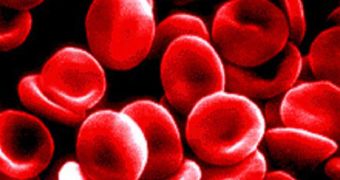1. Blood has the role of transporting food and oxygen to the cells, and to remove toxic wastes, including carbon dioxide. An average human adult has 5 liters of blood which comprises about one liter of oxygen, a quantity which, in resting conditions, would be enough for 4 minutes (in case of intense effort, just 1 minute). Moreover, not all the oxygen is passed to the cells, the blood allowing the passing of a certain oxygen amount, but it does not stay too much.
2. The center of the circulatory system is represented by the heart, with two muscular pumps, a right one and a left one. The right pump realizes the small circulation, sending blood to the lungs where it gets oxygenated. From the lungs, blood gets into the left pump, being distributed into the body through arteries.
Large arteries have muscular walls which regulate the blood flow through contraction or relaxation. The arteries ramify, turning increasingly thinner until reduce to capillaries. The capillaries have a diameter of 1/100 of a millimeter, and they are the only place where the blood works.
Through their walls the exchange of oxygen, carbon dioxide, nutrients and wastes takes place. The total surface of capillaries in the human body bypasses 6,000 square meters. Their volume is too high to be filled by blood all in the same time, and they can relax or contract, depending on the necessities.
Oxygenated blood is lighter; blood with carbon dioxide is darker. The dark blood filled by carbon dioxide and wastes passes into venules, then into larger veins that carry it back to the heart, to its right side. The vein wall has folds (valvules) that direct the blood only towards the heart.
3. In resting conditions, 28 % of the blood pumped by the heart passes through the liver, 24 % through the kidneys, 15 % through the muscles, 14 % through the brain and only 5 % to the heart wall. The numbers can modify, depending on the situation.
4. When a muscle makes an effort, the increased carbon dioxide amount dilates its blood vessels, which absorb more blood in the detriment of other organs. When the muscle does not work, the vessels contract, granting the blood for other organs. If the mechanism does not work, the exercising muscle does not receive enough blood, appearing the muscular cramp.
When making an effort, skin vessels dilate too, for expelling the surplus of resulting heat into the atmosphere. This makes us blush while exercising.
5. The brain is the most sensitive organ to the lack of oxygen, that's why it has a special system of self-regulation which maintains blood circulation to the brain at an acceptable level even when the blood supply of other organs decreases dramatically, like in case of a hemorrhage.
6. Clotting is the process through which blood loss through wounds is stopped. The process starts as soon as blood cells enter in contact with the air, but also inside the circulatory system. "Wrong" clotting causes blood clots (thrombosis). On small vessels, the blood can be easily diverted to lateral vessels in case of thrombosis; in other cases the clot dissolves itself, but if none of these processes occur, surgery must be made.
7. The contraction and the relaxation of the heart modify constantly the blood pressure in the arteries. The peak value, during the contraction, is systolic; the minimum value, while the heart relaxes, is diastolic. The arterial pressure of a healthy young person is 120/80 in mmHg. Anger or physical effort increases pressure, but after that its values drop back. Disease and aging can increase pressure in a constant way (hypertension). Hormonal impairments (like too much adrenaline or renin) can increase blood pressure too. Hypertension can cause heart failure (the heart works too much), stroke, or even sight impairment (if eye vessels are harmed).
Values of 160/100 are considered morbid. Minimal values of 80/40 are not compatible with life.
Hypotension (low blood pressure) can be caused by hemorrhage, heart attack or final stages of some diseases. Low pressure means blood does not reach the organs, and this translates into death in a certain time period. Drugs can make vessels to contract and increase pressure.
8. Atherosclerosis is a disease specific to the developed world. It starts with the storing of fat (especially cholesterol) on the inner walls of the arteries. The wall turns irregular, increasingly thick and rigid, its caliber dwindle, turning the blood flow increasingly difficult. It is caused by diet, genetics, obesity, sedentariness, smoking and stress. Atherosclerosis causes hypertension and even heart attack, if the arteries get obstructed.

 14 DAY TRIAL //
14 DAY TRIAL //